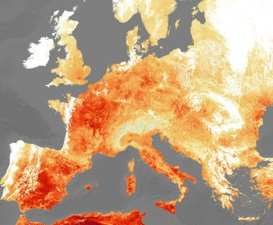Why Are Winters Getting Warmer in Europe?
As global climate change intensifies, people are experiencing increasingly frequent "warm winters."

- Due to its vast north-south span, the tropical region receives more solar radiation due to its longer daylight hours and higher solar altitude, making it even warmer. Driven by low-latitude easterly winds, the South Equatorial Current flows westward to Cape St. Roch on the South American continent, where it is blocked and diverted. Its northern branch, the Guyana Current, flows along the South American continent through the Caribbean Sea into the Gulf of Mexico.
- Carried by trade winds, the warm waters of the Gulf of Mexico converge through the narrow Florida Straits, becoming the high-temperature, high-velocity Florida Current. This converges with the Antilles Current, the northern branch of the North Equatorial Current, to form the powerful Gulf Stream. Formed by the merging of the northern and southern equatorial currents, the Gulf Stream maintains exceptionally high temperatures. The Gulf Stream flows northward along the east coast of the United States, splitting at 45°N latitude and 45°W longitude. All of its branches are collectively known as the North Atlantic Current. This warm current stretches 10,000 kilometers and can reach speeds of up to 2 meters per second. As early as 1513, Spanish explorer Ponce de León noted that this powerful current significantly accelerated his voyage from Mexico to Spain.

- The extreme weather in Europe at the start of the year is sounding the alarm for global climate change! Maximiliano Herrera, a climatologist who tracks extreme weather around the world, described the event as "the most extreme event ever recorded in European climatology" and said, "Nothing compares to it."
- The World Meteorological Organization stated that a combination of factors contributed to this European "warm winter": a high-pressure area over the Mediterranean and a low-pressure system in the Atlantic triggered a strong southwesterly flow, bringing warm air from northwest Africa to the mid-latitudes. Due to above-normal sea surface temperatures, this air warmed further as it passed over the North Atlantic. In the eastern North Atlantic, sea surface temperatures were 1 to 2°C above normal.
- British meteorologist Scott Duncan believes that the cause of the extreme heat is difficult to pinpoint, and that La Niña and unusually warm seas may be driving factors. However, the fundamental reason is that "a warming atmosphere and ocean are making record-breaking temperatures more frequent."




